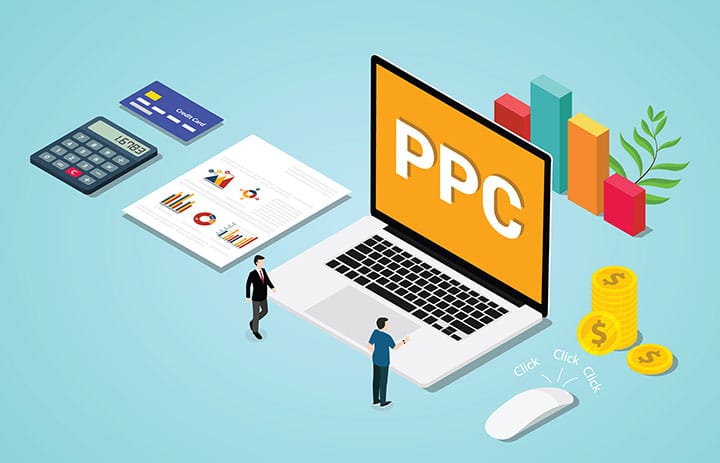Share This
Getting Started With Paid Social Media Ads

Paid social media advertising has gradually emerged as one of the most critical components of many businesses’ marketing plans. This popular marketing strategy allows businesses to reach their target audiences on a massive scale for a relatively low upfront investment.
Paid social media advertising campaigns are very effective at driving conversions while maintaining low advertising costs, resulting in high returns on investment (ROI). As the majority of people spend a significant amount of their time on social media platforms, businesses can easily leverage these channels to connect with target demographics and increase brand awareness.
This article will provide a comprehensive guide to help businesses get started with paid social media ads. We will cover the essential steps for launching a successful paid social media advertising campaign, including identifying goals and target audience segments, selecting appropriate platforms and ad formats, designing engaging ad content, tracking and optimizing campaign performance, and more.
Define Your Advertising Goals and Objectives
Defining clear and specific goals that support business objectives is a critical first step toward aligning your paid social media efforts with your overall marketing strategy. Additionally, without clearly defined objectives, it’s very challenging to measure a campaign’s return on investment.
Some common advertising objectives include increasing brand awareness, improving lead generation, boosting conversions and sales, and attracting more website traffic.

Identify Your Target Audience
Knowing your target audience helps you create relevant and engaging content that resonates with potential customers and drives conversions — ultimately maximizing your paid social media campaign’s return on investment.
Techniques such as analyzing website data, conducting surveys, and studying market research can provide valuable insight into your business’s target audience. Furthermore, segmenting customers according to demographic data such as age, location, or interests and psychographic data such as attitudes, values, or lifestyle can help your business avoid wasting time and resources on irrelevant messaging.
You can also use audience targeting tools available on social media platforms to segment your audience and gain deeper insights into how to reach each group. For example, you can explore adjacent audiences to find people who are similar to your business’s existing customers or use retargeting to reach people who have previously interacted with your business.
Choose the Right Platforms and Ad Formats
Some of the most popular social media platforms for advertising include Facebook, Instagram, LinkedIn, and Pinterest — however, each of these social media platforms serve different audiences and support different types of ads.
Start by learning all you can about your target audience, including interests, behaviors, and stages in the customer journey. Then, consider your objectives, such as increasing brand awareness, generating new leads, or driving sales from current customers.
Next, test different ad formats and analyze their performances to determine which formats are most effective for connecting with your audience and achieving your objectives. You can also utilize social media platform targeting options to ensure your ads are shown to the most relevant groups.

Set a Budget and Bidding Strategy
The bidding process determines the cost per click, cost per impression, or cost per action that a business will pay to a platform to advertise to a specific target audience on that platform.
- Cost per click (CPC) – Businesses pay for each individual click on their ads.
- Cost per impression (CPM) – Businesses pay for every thousand ad impressions.
- Cost per action (CPA) – Businesses pay when a user completes a desired action, such as making a purchase or submitting a form.
To optimize your budget allocation and bidding strategy, begin by aligning your bidding strategies with your campaign objectives — for example, if your goal is to drive website conversions, use a cost-per-action bidding strategy. Then, create specific ad sets for different audience segments and allocate more budget to audiences that have higher conversion rates. You should also monitor the performance of your ads so you can increase bids for successful ads and decrease bids for underperforming ads.
Craft a Customer-Centric Offer
Customer-centric offers focus on providing value by meeting the specific needs of your target audience and fostering stronger relationships between your business and its customers. To maximize your chances of converting leads with your ads, it’s important to make your product offer the easiest entry point in the market. Your offer also needs to solve a real problem and provide tangible value to your customers.
However, the best offer is one that not only solves a problem but also highlights a subsequent problem for which your business can provide the solution. This creates a cycle of value and keeps your customers coming back to your business.

Design High-Quality, Engaging Ads
With so much competition for users’ attention on social media platforms, businesses need to create ads that stand out. Just as importantly, social media algorithms favor visually appealing content, making high-quality ads more likely to appear to larger audiences.
To design visually-appealing social media ads with high engagement potential, use vibrant colors and high-quality images or videos that will stand out in users’ feeds. Avoid cluttered designs and aim for simple, clean layouts that convey your messaging clearly and concisely. Don’t forget to align your ads with your brand’s overall look and feel, including color scheme, font choice, and imagery.
Designing Effective CTAs and Value Propositions
An ad’s call to action (CTA) tells the audience what they should do next after seeing the ad, while the value proposition explains why they will benefit from taking that action.
To create effective calls to action and clear value propositions, include language that is direct and easy to understand. Use strong action verbs to guide viewers toward the desired action and leverage persuasive language to convince your audience that they need what you are offering.
Write Compelling Ad Copy
Effective ad copy starts with a clear and compelling headline that immediately communicates your business’s value proposition. Ad text should be concise, benefit-driven, and tailored to your target audience’s specific needs and pain points.
Here are a few tips for writing compelling and persuasive ad copy:
- Use emotional language and storytelling to connect with your audience.
- Highlight unique selling points that differentiate your business from competitors.
- Include a clear call to action that motivates potential leads to take a concrete next step.
Examples of persuasive ad copy in action include social proof like customer testimonials, limited-time offers that generate a sense of urgency, and upfront rebuttals of common objections.

Optimize Landing Pages for Conversions
Landing pages can make or break your conversion rates. Successful landing pages create a positive first impression and increase the number of leads or sales you generate, while poorly designed landing pages lead to high bounce rates and wasted ad spend.
Optimizing User Experience
First, consider the user experience. A cluttered landing page can be overwhelming and distracting for potential leads. Focus on the main message you want to convey and use clear, concise language to communicate it.
Each landing page should also align with the overall messaging and design of your ad. Use the same colors, fonts, and imagery to create a cohesive user experience, and choose high-quality images or videos to showcase your product or service.
Optimizing Conversions and Bounce Rate
Next, you need to optimize your landing pages for maximum conversions. Start by testing different headlines, ad copy, visuals, and CTAs to see which combinations work best. Then, optimize your landing pages for both desktop and mobile users, and streamline code to improve page speed and reduce bounce rates.
Test and Refine Your Ad Creative and Targeting
Ongoing testing helps you better understand your audience and enables more personalized and engaging ad experiences over time. Additionally, by continuously testing and refining, you can stay ahead of the competition and adapt quickly to changes in the market.
Some of the best techniques for A/B testing include:
- A/B test ad creative variations, including headlines, copy, images, videos, and CTAs, to see which perform best.
- A/B test audience targeting options, including demographics, interests, behaviors, and lookalike audiences, to see which result in the most engagement.
- A/B test landing page variations to see which combinations of visual design and messaging lead to the highest conversion rates.

Monitor and Measure Campaign Performance
Tracking campaign performance makes it easier to identify which advertising tactics are working and which are not. The most important KPIs to monitor include:
- Click-Through Rate (CTR) – The percentage of users who clicked on your ad after seeing it.
- Conversion Rate – The percentage of users who completed a desired action, such as filling out a form or making a purchase.
- Return On Ad Spend (ROAS) – The amount of revenue generated for every dollar spent on advertising.
The best tools and resources to help you track social media ad performance metrics include Facebook Ads Manager, Google Analytics, Hootsuite Insights, and Sprout Social. Using tools like these can help you unlock valuable insights that enable better data-driven optimization.
Scale and Optimize Your Paid Social Media Strategy
Scaling your social media ad campaigns effectively is the key to reaching wider audiences, driving more traffic, and increasing brand awareness. Additionally, by continuously optimizing your strategy, you can adapt to changes in the market and keep your ad campaigns competitive.
To identify opportunities for growth, you can test different targeting options such as interests, behaviors, and demographics. You can also consider expanding to new social media platforms or other digital channels. Refining your messaging to speak to new audience segments and address new pain points is another effective strategy.
Conclusion
Launching successful paid social media ad campaigns requires a strategic and data-driven approach. To get started, businesses should define their goals, identify their target audiences, select the best platforms and ad formats, and set a budget and bidding strategy.
The next step is to craft customer-centric offers, design high-quality and visually engaging ads, write compelling ad copy, and optimize landing pages for conversions. Once your ads are live, remember to keep testing and refining ad creative and targeting options, monitoring campaign performance, and scaling and optimizing your strategy over time.
By following these essential steps and maintaining an adaptable and data-driven approach, businesses can create successful paid social media ad campaigns that accomplish their goals and achieve maximum ROI.